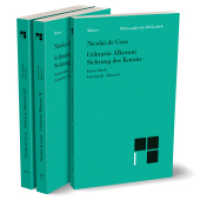- ホーム
- > 洋書
- > 英文書
- > Business / Economics
Full Description
The Arab World edition of N. Gregory Mankiw's Principles of Economics is essential reading for economics students in the Middle East and those with an interest in Islamic finance. Using Mankiw's classic ten principles approach to economics, the book provides students with a framework for understanding the economy of the world they live in. Written in an engaging and accessible style and designed to encourage students to think like an economist, the text equips them to engage confidently and critically with theories and principles of economics.
Following on from the successful fourth edition, this text contains updated case studies, news articles and features that focus on the Arab world and current global challenges. This fifth edition is also available as a MindTap, a fully interactive learning platform with an interactive eReader, assessment questions, revision aids and engaging multimedia to explain key concepts and further case studies. It also provides analytics to help you keep track of students' progress.
Contents
Part One: Introduction
1. Ten principles of economics
2. Thinking like an economist
3. Interdependence and the gains from trade
Part Two: How markets work
4. The market forces of supply and demand
5. Elasticity and its applications
6. Supply, demand and government policies
Part Three: Markets and welfare
7. Consumers, producers and the efficiency of markets
8. Application: The costs of taxation
9. Application: International trade
Part Four: The economics of the public sector
10. Externalities
11. Public goods and common resources
12. The design of the tax system
Part 5: Firm behavior and the organization of industry
13. The costs of production
14. Firms in competitive markets
15. Monopoly
16. Monopolistic competition
17. Oligopoly
Part 6: The economics of labor markets
18. The markets for the factors of production
19. Earnings and discrimination
20. Income inequality and poverty
Part 7: Topics for further study
21. The theory of consumer choice
22. Frontiers of microeconomics
Part 8: The data of macroeconomics
23. Measuring a nation's income
24. Measuring the cost of living
Part 9: The real economy in the long run
25. Production and growth
26. Saving, investment and the financial system
27. The basic tools of finance
28. Islamic finance
29. Unemployment
Part 10: Money and prices in the long run
30. The monetary system
31. Money growth and inflation
Part 11: The macroeconomics of open economies
32. Open-economy macroeconomics: Basic concepts
33. A macroeconomic theory of the open economy
Part 12: Short-run economic fluctuations
34. Aggregate demand and aggregate supply
35. The influence of monetary and fiscal policy on aggregate demand
36. The short-run trade-off between inflation and unemployment
Part 13: Final thoughts
37.Six debates over macroeconomic policy







